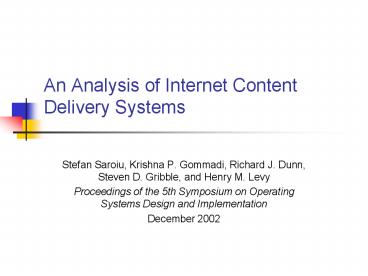An Analysis of Internet Content Delivery Systems PowerPoint PPT Presentation
Title: An Analysis of Internet Content Delivery Systems
1
An Analysis of Internet Content Delivery Systems
- Stefan Saroiu, Krishna P. Gommadi, Richard J.
Dunn, Steven D. Gribble, and Henry M. Levy - Proceedings of the 5th Symposium on Operating
Systems Design and Implementation - December 2002
2
Outline
- Goals of Paper
- Overview of Content Delivery Systems
- Experimental Methodology
- Results
- Caching
- Conclusions
3
Goals
- Quantify the increasing importance of novel
content delivery systems - Characterize the behavior of these systems from
the perspectives of clients, objects, and servers - Derive implications for caching in these systems
4
Content Delivery Systems
- HTTP Web Traffic
- Content Delivery Networks
- Akamai
- Peer-to-peer file sharing networks
- Gnutella
- Kazaa
5
HTTP Traffic
- Clients request objects from web servers using
HTTP - Most web objects are small, 5-10KB.
- Web object requests follow a Zipf-like
distribution - Caching
- Cache hit rate increases logarithmically with
client population - Impossible for dynamic content
6
Zipf Distribution Compared with Sun Log Data
7
Content Delivery Networks (CDNs)
- Dedicated collections of servers that are
geographically distributed - Provide static content, e.g. images, streaming
video - Allows user to access replica of content that is
close - Replica location done via DNS interposition or
URL rewriting at origin servers - Redirection adds overhead
- Reduces average download response time
8
Peer-to-Peer Systems
- Peers form a distributed system to exchange
content - Batch-style downloads
- Most peers have low-availability and limited
network capacity - Files transferred via direct connection between
peers
9
Experiment Methodology
- Use passive network monitoring to collect trace
of TCP traffic between University of Washington
(UW) to rest of Internet - Collected 9 days of data, over 20 TB
10
Some Interesting Observations
- UW is an HTTP content provider
- Exported 16.65 TB. Imported 3.44 TB
- Bandwidth consumption (inout)
- .2 Akamai
- 6.04 Gnutella
- 14.3 WWW
- 36.9 Kazaa
- Rest is other TCP protocols mail, streaming
video/audio, etc.
11
Some More Interesting Observations
- Compared to 1999 study
- HTML traffic has decreased 43
- GIF/JPG traffic has decreased 59
- AVI/MPG traffic increased nearly 400
- MP3 traffic increased nearly 300
12
Objects
- Median P2P object size is 4MB.
- Median Web object is 2KB
- 5 of Kazaa objects are over 100MB
- Top 1 of Kazaa objects account for 50 of bytes
transferred - For Web, top 1 account for 16 of bytes
transferred
13
Clients
- For both Web and Kazaa, small number of clients
account for large portion of traffic - In Web, top 200 clients (0.5 of the population)
account for 13 of the traffic - In Kazaa, top 200 clients (4 of the population)
account for 50 of the traffic
14
Servers
- Would expect server load for Kazaa to be much
more distributed than for WWW - This is not the case
- Top 500 external Web servers provide 22 of the
bytes - Top 500 external Kazaa servers provide 10 of the
bytes
15
Scalability
- With respect to bandwidth cost adding another
450 Kazaa clients would be equivalent to doubling
the web client population (from 40,000 to 80,000)
16
CDN Caching
- Do CDNs provide any performance benefits over
local proxy cache? - If Akamai traffic were directed to proxy cache
instead - 88 ideal object hit rate (all objects cacheable)
- 50 practical hit rate
- Conclusion Widely deployed proxy caches reduce
need for separate CDNs
17
P2P Caching
- Inbound cache byte hit rate 35
- Outbound cache byte hit rate 85
- Hit rate increases with client population
- 1,000 clients 40 hit rate
- 500,000 clients 85 hit rate
- Conclusion Reverse P2P cache saves the most
bandwidth
18
Conclusions
- P2P traffic accounts for majority of HTTP bytes
transferred - P2P objects are significantly larger than Web
objects - Small number of large objects account for a large
percentage of P2P traffic - Small number of clients and servers responsible
for majority of P2P traffic - P2P traffic creates significant bandwidth load

